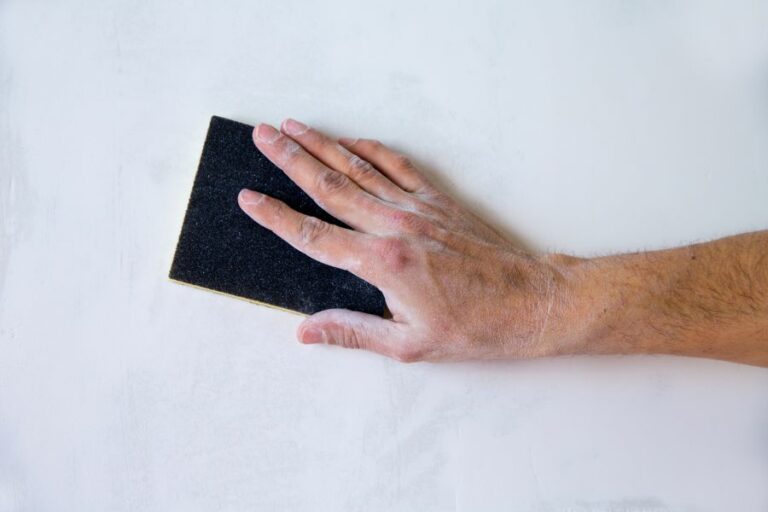Paint Removers For Effective Surface Prep, What Pros Say
Paint removers can be a game-changer regarding effective surface preparation, as getting rid of old and stubborn paint can often feel like an uphill battle. Luckily, we have the solution to help you tackle even the most challenging paint removal projects, ensuring a pristine and ready-to-go surface.
Paint removers for effective surface prep:
For effective surface preparation, consider the following paint removers: solvent-based (effective on various paint types but toxic), bio-based (eco-friendly but may be less effective), and caustic-based (effective on oil-based paints but damaging to certain surfaces). Mechanical methods, like sanding and scraping, can also be used. Choose a remover based on paint type, surface, environmental concerns, application method, and cost.

Looking for the perfect paint remover to ensure a smooth and clean surface for your next project? Read on to discover various paint removers, tips for effective use, and the key to achieving a professional finish! Stay tuned for more.
Contents
- 1 Efficient Paint Stripping Solutions for Surface Preparation
- 2 Expert Painters’ Preferred Tools for Paint Removal
- 3 Top-Rated Solvents for Effective Paint Stripping
- 4 Essential Tools for Removing Paint from Surfaces
- 5 Two Prevalent Techniques for Eliminating Paint
Efficient Paint Stripping Solutions for Surface Preparation
A crucial aspect of any painting project, be it residential, commercial, or industrial, is preparing the surface.
This often involves removing old paint or coatings to create a clean, smooth surface that new paint can adhere to. To achieve the desired results, it’s essential to choose the right paint remover for the job at hand.
• Types of Paint Removers
– Solvent-based Paint Removers
Solvent-based paint removers are one of the most common types, known for being effective in removing a wide variety of paint types, including oil-based, latex, and epoxy paints.
They utilize chemicals like methylene chloride, acetone, or NMP (N-methyl-2-pyrrolidone) to soften and dissolve the old paint, making it easier to scrape off the surface.
Pros:
- Effective on various types of paint
- Often work quickly
- Easy to find in most hardware stores
Cons:
- Can be toxic and harmful to the environment
- May require proper ventilation and safety precautions, like wearing gloves and masks
- May damage some surfaces, like plastic
– Bio-based Paint Removers
Bio-based paint removers are a more environmentally-friendly alternative to traditional solvent-based removers. These products typically use plant-derived ingredients, like soy or citrus, to loosen and remove paint without the use of harsh chemicals.
Pros:
- Lower toxicity and environmental impact
- Safe for use on various surfaces, including plastic
- Can be more pleasant to work with due to reduced odor
Cons:
- May not be as effective on some types of paint
- May require longer soaking times compared to solvent-based removers
- Can be more expensive than other options
– Caustic-based Paint Removers
Caustic-based paint removers use alkaline chemicals, like sodium hydroxide or potassium hydroxide, to break down the paint layers. These products are particularly effective on oil-based and some alkyd paints but may not be suitable for latex or acrylic-based paints.
Pros:
- Effective on oil- and alkyd-based paints
- Can remove multiple layers of paint at once
- Typically less expensive than solvent- or bio-based alternatives
Cons:
- Can damage some surfaces, like aluminum and other soft metals
- Risk of burns from contact with caustic chemicals
- High toxicity and environmental concerns
– Mechanical Paint Removal Methods
In addition to the chemical-based paint removers discussed above, mechanical methods like sanding, scraping, or using power tools, such as grinders and paint shavers, can also effectively remove old paint.
Though not technically “paint removers,” these methods offer an alternative, especially when combined with chemical paint removers for stubborn spots.
Pros:
- Can be highly effective
- Environmentally friendly, as they don’t involve the use of chemicals
- Often cost-effective, depending on the tools used
Cons:
- Can be labor-intensive and time-consuming
- May create a significant amount of dust and debris
- Risk of damaging the surface when using power tools
• Factors to Consider When Choosing a Paint Remover
– Type of Paint and Surface
It’s vital to consider the type of paint being removed, as well as the surface it’s on, when choosing a paint removal method. For example, some paint removers may damage plastic surfaces or not be effective on certain types of paint.
Consult the product’s label or manufacturer to ensure that it’s suitable for the specific paint and surface in question.
– Environmental and Safety Concerns
As some paint removers can be toxic, harmful to the environment, or both, it’s essential to consider the environmental and safety impacts of your choice.
Opt for less-toxic options, like bio-based removers, whenever possible, and always wear appropriate personal protective equipment (gloves, masks, and goggles) while using paint removers.
– Method of Application and Cleanup
Different paint removers may require different application and cleanup techniques. For example, caustic-based removers often need a neutralizing step to prevent further damage to the surface.
Ensure you’re comfortable with and prepared for the specific method required by the paint remover you choose.
– Cost and Availability
Lastly, consider the cost and availability of the paint remover, bearing in mind that less expensive options may take longer or require more effort, while some specialty removers may not be available at local hardware stores and may need to be ordered online or from specialized retailers.
• Final Thoughts
Choosing the right paint remover is a critical step in ensuring a successful painting project.
By considering factors like the type of paint and surface, environmental and safety concerns, the method of application, and cost, you can find the most effective and efficient paint remover for your specific needs.
For additional information on paint removal techniques and regulations, consider visiting the EPA’s website on Lead Paint Removal for guidance and best practices.
Expert Painters’ Preferred Tools for Paint Removal
• Chemical Paint Removers
Professional painters often use chemical paint removers to strip away layers of paint with minimal effort. These powerful solutions penetrate the paint’s surface, softening or dissolving the bond between paint and substrate, making it easier to remove.
There are three primary types of chemical paint removers:
– Solvent-Based Removers
Solvent-based paint removers, also known as paint strippers, use a combination of chemicals to soften and dissolve paint layers. Some of the most effective solvents include methylene chloride, N-methylpyrrolidone (NMP), and acetone.
Due to their strong fumes, solvent-based paint removers require proper ventilation and protective gear, such as gloves and a respirator.
I recommend using a solvent-based remover for stubborn or multiple layers of paint. However, be sure to follow the manufacturer’s instructions and safety precautions to avoid potential health risks.
– Caustic-Based Removers
Caustic-based paint removers contain alkaline chemicals, such as sodium hydroxide or potassium hydroxide, to break down the paint’s structure.
These removers are less toxic than solvent-based options but can still cause skin irritation or damage certain surfaces.
Caustic-based removers work best on oil-based paints and are not as effective on water-based or latex paints. I recommend testing a small area before applying the remover to the entire surface.
– Bio-Based Removers
These environmentally-friendly paint removers use natural ingredients (such as soy, orange oil, or plant-based esters) to loosen and lift paint layers.
Bio-based removers typically have lower or no volatile organic compounds (VOCs), making them safer for the user and the environment.
While bio-based removers may be slower-acting than their chemical counterparts, I recommend them for those who are concerned about the potential hazards of using harsh chemicals.
• Mechanical Paint Removal Methods
– Scraping and Sanding
For small paint removal projects or hard-to-reach areas, professional painters typically rely on manual methods like scraping and sanding.
A variety of hand tools, such as paint scrapers, putty knives, or wire brushes, can be used to remove paint from surfaces. For larger areas, an electric sander with different grit sandpapers can help speed up the process.
However, be cautious when sanding or scraping surfaces with lead-based paint, as it can create hazardous dust. Follow the Environmental Protection Agency (EPA) guidelines for lead-safe work practices.
– Heat Guns
A heat gun is an electrical device that produces a hot air stream, allowing professional painters to soften paint layers for easier removal. Heat guns are efficient for stripping paint from wood surfaces, moldings, and intricate details without the use of chemicals.
When using a heat gun, it’s important to maintain a safe temperature to avoid scorching the surface or generating toxic fumes, especially from lead-based paint. I recommend keeping the heat gun below 1100F and using a respirator for added safety.
– Pressure Washing
Professional painters often use pressure washers for outdoor paint removal projects, such as exterior siding, decks, fences, and concrete surfaces. Pressure washing uses a high-powered stream of water to remove loose paint, dirt, and grime from surfaces.
Before pressure washing, it’s essential to prepare and protect the surrounding area by covering plants, windows, and other delicate items. Use caution when adjusting the pressure, as it can damage some surfaces or cause paint to splatter.
• Infrared Paint Removers
Infrared paint removers use heat in the form of infrared radiation to soften multiple layers of paint for easy scraping.
These devices are designed to loosen paint without damaging the underlying surface or generating hazardous dust. Infrared paint removers are especially useful for wooden surfaces, such as window frames and antique furniture restoration projects.
While infrared paint removers may be more expensive than some other options, I recommend them for safe, efficient, and eco-friendly paint removal tasks.
Each paint removal method has its advantages and drawbacks, depending on the specific project and type of paint. Professional painters have an arsenal of paint removal methods at their disposal to achieve the best results.
By evaluating factors such as efficiency, safety, and environmental impact, you can select the paint removal method that best suits your needs.
Top-Rated Solvents for Effective Paint Stripping
When it comes to removing paint from various surfaces, finding the best solvent for the job can feel overwhelming.
With numerous chemical paint removers available in the market, we aim to guide you through the process of selecting the ideal solvent for stripping paint, depending on the surface and the type of paint being removed.
• Chemical Paint Strippers: A Brief Overview
Chemical paint strippers are either solvent-based or caustic. Solvent-based paint strippers penetrate the layers of paint and break the bond between the paint and the surface.
Caustic paint strippers, on the other hand, contain lye, which react with the paint and make it easier to remove.
While there are eco-friendly and bio-based options available, most traditional paint strippers are classified as hazardous materials due to their harmful chemicals and potential health risks.
– Safety Precautions When Using Chemical Paint Removers
Before diving into a list of suggested solvents, it’s essential to remember that safety should be a priority when working with chemical paint removers. Be sure to:
- Follow the manufacturer’s instructions on the label
- Wear appropriate personal protective equipment (PPE), such as gloves, goggles, and a mask, especially when dealing with toxic solvents
- Work in a well-ventilated area to avoid inhaling harmful fumes
- Properly dispose of used materials and solvents according to local regulations
• Top Solvent-Based Paint Strippers
1. Methylene Chloride
Methylene chloride, also known as dichloromethane, is one of the most potent and effective solvents for removing numerous types of paint, including epoxy, polyurethane, and alkyd-based paints. It works quickly and can strip multiple layers of paint in one application.
However, it poses serious health risks, such as skin irritation, toxic fumes, and potential damage to the nervous system. Therefore, it should be used with extreme caution and adequate protective gear.
Due to these risks, methylene chloride-based paint strippers are being phased out in favor of safer alternatives.
2. N-Methyl-2-Pyrrolidone (NMP)
NMP is a high boiling point compound and a very effective solvent for stripping paint. It’s particularly efficient at removing water-based paints, such as latex and acrylic, from wood, metal, and masonry surfaces.
While less toxic than methylene chloride, NMP can still cause skin irritation, and its fumes can be harmful. Therefore, proper safety measures must be observed when using NMP-based paint strippers.
3. Soy Gel
Soy gel paint strippers are a more environmentally friendly option, derived from soybean oil. Although this bio-based solvent may work more slowly than its chemical counterparts, it’s highly effective at removing paint and varnish from wood, metal, and concrete surfaces.
It’s also safe for indoor use due to its low odor and minimal risk of skin irritation. For those looking for an eco-friendly paint stripping solution, soy gel is a recommended choice.
4. Acetone
For removing smaller amounts of paint or for spot removal, acetone is an effective option. It’s especially useful when working with epoxy, lacquer, and some varnishes. Acetone is readily available as a common paint thinner and can also be used to clean tools and brushes.
Remember that acetone is highly flammable, and its fumes can be hazardous; therefore, it’s crucial to work in a well-ventilated area and store it safely.
• Top Caustic Paint Strippers
1. Sodium Hydroxide (Lye)
Sodium hydroxide, commonly known as lye, is a powerful caustic paint stripper that works well on wood surfaces. Lye-based paint strippers effectively remove oil-based and alkyd paints by reacting with the paint and turning it into a soap-like substance that can be easily washed away.
However, lye is highly corrosive and can burn the skin, eyes, and respiratory passages. When using lye-based paint strippers, taking appropriate safety measures is necessary, including wearing PPE and avoiding inhalation of the fumes.
2. Potassium Hydroxide
Similar to sodium hydroxide, potassium hydroxide is a caustic paint stripper that works by converting the paint into a washable residue. It’s especially effective on masonry surfaces, such as brick and concrete. Like lye, potassium hydroxide can be corrosive and pose health risks if not handled properly.
Always follow the manufacturer’s guidelines and precautions when using potassium hydroxide-based paint strippers.
• Conclusion
Ultimately, the ideal solvent for stripping paint will depend on various factors, such as the type of paint, the surface, and your concerns about health and environmental risks.
Always prioritize safety when working with chemical paint removers and make an informed decision on the best solvent for your paint stripping needs.
Solvent | Description | Pros | Cons |
|---|---|---|---|
Methylene Chloride | A powerful solvent, also known as dichloromethane. | Fast acting, effective on most paint types. | Potentially harmful fumes, may damage some surfaces. |
Acetone | A common solvent used in various industries. | Effective for some paints, easily available. | Not effective on all paint types, flammable. |
Paint Thinner | A solvent specifically designed for thinning and stripping paint. | Formulated for the task, works on most paints. | Can be slow, produces fumes. |
Turpentine | A solvent obtained from the distillation of pine resin. | Effective for oil-based paints, natural product. | Pungent odor, slow to work. |
Bio-based Paint Removers | A range of environmentally-friendly, plant-based solvents. | Less harmful fumes, safer for the environment. | May be less effective, slower to work. |
Essential Tools for Removing Paint from Surfaces
Removing paint from a surface can be a tedious and time-consuming task, but it’s crucial when preparing for a renovation or repainting project. There are several methods, both chemical and mechanical, to remove paint effectively.
• Chemical Paint Removal Techniques
Chemical paint removers, also known as paint strippers or removers, work by breaking down the paint’s molecular structure, making it easier to remove from surfaces. There are three primary types of chemical paint removers: solvent, caustic, and bio-based.
– Solvent-Based Paint Removers
Solvent-based paint removers use chemicals, such as methylene chloride and N-methyl-2-pyrrolidone (NMP), to dissolve paint. Though they are effective, they can also be highly toxic, making them less desirable for some projects.
I recommend using solvent-based paint removers in well-ventilated areas and wearing appropriate protective gear, such as gloves and goggles. Make sure to follow the manufacturer’s instructions carefully to ensure optimal results.
– Caustic Paint Removers
Caustic paint removers, also known as alkaline removers, contain sodium hydroxide, which reacts with the paint to break it down. This type of paint remover can be effective but may cause damage to certain surfaces, such as softwoods or metals.
If you choose a caustic paint remover, make sure to neutralize the surface after removing the paint to prevent damage. You can do this by applying a mild acid, like vinegar or citric acid, to the surface.
– Bio-Based Paint Removers
Bio-based paint removers, also known as eco-friendly or “green” removers, use natural ingredients derived from plants and animals to loosen and dissolve paint. These removers tend to be less toxic and more environmentally friendly than their chemical counterparts.
For an environmentally friendly option, consider using a bio-based paint remover and carefully follow the manufacturer’s instructions for optimal results.
• Mechanical Paint Removal Techniques
Mechanical paint removal methods involve using tools and abrasive materials to physically scrape, sand, or grind away the paint from the surface. This can be an effective approach, particularly for removing small areas of paint or tackling stubborn layers.
– Scraping and Sanding
Scraping and sanding are two common techniques for mechanically removing paint. Scraping involves using a paint scraper or putty knife to chip away at the paint, while sanding uses an abrasive material like sandpaper to wear it down.
For a relatively smooth surface with minimal texture, these methods can work well, but they can be time-consuming and labor-intensive. Consider using an electric paint stripper or orbital sander to speed up the process.
– Wire Brushes and Abrasive Pads
Wire brushes and abrasive pads can be used to remove paint from tougher surfaces, such as concrete or masonry. These tools are designed to be very abrasive, so take care not to damage the underlying surface.
Be sure to choose the right type of wire brush or abrasive pad for your project to avoid causing damage to the surface underneath the paint.
– Pressure Washing
Pressure washing is a popular method for cleaning exterior surfaces like siding or concrete. It can also be used to remove paint, particularly in instances where the paint is already peeling or flaking off.
When using a pressure washer, make sure to follow the manufacturer’s guidelines for pressure and nozzle settings to avoid damaging your surface.
– Heat Removal Techniques
Heat removal techniques involve applying heat to the paint to soften it, making it easier to remove with a scraper or other tools. For this method, you can use a heat gun, infrared paint stripper, or a steamer.
I recommend using a heat gun with a built-in temperature control, as this ensures you won’t accidentally damage the surface beneath the paint. Keep in mind that heat removal techniques should not be used on surfaces where there’s a potential for lead-based paint, as heating the lead can release toxic fumes.
• Precautions and Safety
When conducting any paint removal project, make sure to wear appropriate protective gear like gloves, goggles, and a mask. Also, ensure that the work area is well-ventilated or in an outdoor environment to minimize exposure to potential harmful fumes from paint or chemical removers.
In conclusion, there are various methods and techniques used to remove paint from a surface, ranging from chemical to mechanical methods.
To achieve the best results, make sure to select the appropriate method based on the type of surface and paint to be removed, and always take necessary safety precautions to protect yourself and the environment.
Two Prevalent Techniques for Eliminating Paint
As a professional dealing with paint removal, I have had significant experience with various removal techniques.
• Chemical Stripping
Chemical stripping is a popular method for paint removal, especially for more delicate surfaces. This method involves the use of chemical solutions to dissolve and break down paint layers, making it easier to remove the paint from the surface.
– Types of Chemical Strippers
There are two main types of chemical strippers: solvent-based strippers and caustic strippers.
- Solvent-based strippers dissolve paint through the action of solvents. They are effective at removing multiple types of paint, including varnish, latex, and more. One commonly used solvent-based stripper is methylene chloride, which is available in most hardware stores. These strippers can emit strong fumes, so adequate ventilation is critical during the application process.
- Caustic strippers contain strong alkalis, such as lye or sodium hydroxide, that break down paint by turning it into a soap-like substance. They work best on oil-based paints but are less effective on latex or acrylic paints. Although they have less harsh fumes compared to solvent-based strippers, caustic strippers can cause skin and eye irritation if not used carefully.
– Application Process
- Apply the chemical stripper evenly: Using a brush or roller, apply a thick layer of the chemical stripper to the surface, ensuring that you cover all the paint.
- Allow time for the stripper to work: Consult the manufacturer’s instructions for the recommended waiting time, which can range from a few minutes to several hours, depending on the product and paint type.
- Remove the softened paint: Use a paint scraper or putty knife to gently remove the paint layer by layer. For intricate or detailed surfaces, you may need to use finer tools like a small brush or toothpick.
- Clean the surface: After removing the paint, clean the surface with a damp cloth or sponge to remove any residue.
– Advantages and Disadvantages
Advantages:
- Effective for delicate surfaces where mechanical methods could cause damage
- Can remove multiple layers of paint at once
Disadvantages:
- Can be slow and labor-intensive
- Potential health hazards if used without proper precautions
I recommend chemical stripping for projects that involve delicate surfaces, such as antique furniture or interior woodworking.
To minimize the risk of fumes and other health concerns, ensure proper ventilation and use appropriate personal protective equipment.
• Mechanical Paint Removal
Mechanical paint removal methods are effective for larger surfaces and more robust materials. They involve physical force to remove the paint, and there are several techniques to choose from depending on your project’s needs.
– Common Mechanical Techniques
- Sanding: Sanding is an effective method for removing paint from wood, metal, and other surfaces. Choose the appropriate sandpaper grit for your project and make sure to sand in the direction of the grain. For larger projects, consider using a power sander for efficiency.
- Scraping: For small areas or projects requiring precision, a paint scraper or putty knife can be used for manual paint removal. Ensure you are using the right tool for the material and apply consistent pressure while scraping to avoid damage.
- Heat guns and infrared devices: These tools emit heat to soften the paint, making it easier to remove. They are especially useful for multiple layers of paint and can be used with care on more delicate materials. Follow the manufacturer’s instructions and exercise caution to avoid burns or fires.
– Advantages and Disadvantages
Advantages:
- Effective for larger surfaces and tough material
- Less risk of toxic fumes
Disadvantages:
- Can be labor-intensive and time-consuming
- Potential for surface damage or injury if not done correctly
Mechanical paint removal methods are well-suited for larger scale projects and robust materials like concrete or brick. For best results, use caution and the appropriate tools to avoid damaging the surface or causing injury.
• Conclusion
Both chemical stripping and mechanical paint removal methods have their advantages and disadvantages, depending on the project requirements.
For delicate surfaces or antiques, chemical stripping is the safer choice, while mechanical methods are better suited for large surfaces or robust materials.
With proper research and preparation, you can successfully remove paint from various surfaces using these proven methods.
Method | Description |
|---|---|
Chemical Paint Removers | Chemical paint removers, also known as paint strippers, use chemicals to break down and dissolve the paint. They are applied to the surface and then scraped or wiped away along with the paint. |
Mechanical Paint Removal | Mechanical paint removal involves using tools and equipment, such as sandpaper, scrapers, or power sanders, to manually remove the paint from the surface. This method can be time-consuming and labor-intensive but is effective for removing paint without chemicals. |







